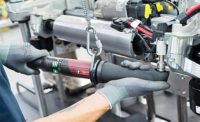Fastening Threads: Problems Solved

Bolted joints are the vast majority of our consulting business. Our work is divided evenly between validating joints under development and troubleshooting problems with existing joints. Our troubleshooting experience led us to develop the matrix below to help engineers solve common problems with bolted joints.
Distilling even the most common problems and solutions into the confines of this column requires simplification that may invite critical judgment from veteran hands. Our experience is that many engineers could benefit from reviewing the relationship between a problem and its likely underlying causes.
One assumption inherent in the matrix is that the joints are fastened with a power tool capable of accurate and repeatable shut-off, such that operator influence is unlikely. Note that angle of rotation is listed as a problem, though only a subset of controlled tools can report angle. Thread strip, bolt failure and high prevailing torque are easily detected with any type of tool. However, they represent extreme problems.
Knowing the angle required to rotate the fastener from a known and repeatable starting point to the target torque provides insight into joint conditions between those extremes. Angle of rotation governs the clamp load, and that, in turn, determines the reliability of most joints.
While not as convenient or accurate as an integral angle encoder, rotation angle can be determined manually by match-marking. Such manual measurements are not done on every joint, so problems caused by clamp load being outside the expected range are not realized until product is in the field. This is one of the main drivers in the expanded use of sensored tools.
Common Installation Problems with Threaded Fasteners
| Problem | Root Cause | Thread Type | More Likely Causes | Less Likely Causes |
| Thread strip or bolt failure | Reduced resistance, often due to lower friction |
Free-running Thread-forming, cutting |
Hardware friction, joint friction Hardware friction, hole size, joint friction |
Joint parallellism, faulty tool shut-off |
| High prevailing torque |
Interference between threads
|
Free-running Thread-forming, cutting |
Coating thickness, thread nicks, cross-threading Hole size, thread nicks, cross-threading |
Joint misalignment, joint parallellism Coating thickness, joint misalignment, joint parallellism |
| High angle of rotation | Less resistance due to lower friction, interference or joint stiffness |
Free-running Thread forming, cutting |
Hardware friction, joint friction, hole size, joint friction | Joint parallellism, faculty took shut-off |
| Low angle of rotation | More resistance due to higher frtiction or interference |
Free-running Thread-forming, cutting |
Hardware friction, hole size, joint friction Hardware friction, holse size, joint friction |
Coating thickness, joint misalignment, joint parallellism, faulty took shut-off Coating thickness, thread nicks, joint misalignment, joint parallellism, faulty tool shut-off |
Looking for a reprint of this article?
From high-res PDFs to custom plaques, order your copy today!



